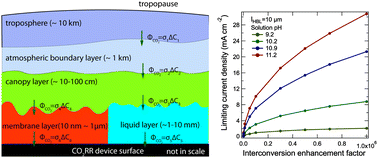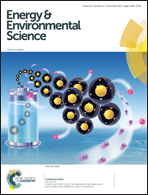Operational constraints and strategies for systems to effect the sustainable, solar-driven reduction of atmospheric CO2
Abstract
The operational constraints for a 6-electron/6-proton CO2 reduction system that operates at the concentration of CO2 in the current atmosphere (pCO2 = 400 ppm) have been evaluated on a variety of scale lengths that span from laboratory scale to global scale. Due to the low concentration of CO2 in the atmosphere, limitations due to mass transport of CO2 from the tropopause have been evaluated through five different regions, each with different characteristic length scales: the troposphere; the atmospheric boundary layer (ABL); the canopy layer; a membrane layer; and an aqueous electrolyte layer. The resulting CO2 conductances, and associated physical transport limitations, will set the ultimate limit on the efficiency and areal requirements of a sustainable solar-driven CO2 reduction system regardless of the activity or selectivity of catalysts for reduction of CO2 at the molecular level. At the electrolyte/electrode interface, the steady-state limiting current density and the concomitant voltage loss associated with the CO2 concentration overpotential in a one-dimensional solar-driven CO2 reduction cell have been assessed quantitatively using a mathematical model that accounts for diffusion, migration and convective transport, as well as for bulk electrochemical reactions in the electrolyte. At pCO2 = 400 ppm, the low diffusion coefficient combined with the low solubility of CO2 in aqueous solutions constrains the steady-state limiting current density to <0.1 mA cm−2 in a typical electrochemical cell with natural convection and employing electrolytes with a range of pH values. Hence, in such a system, the CO2 capture area must be 100- to 1000-fold larger than the solar photon collection area to enable a >10% efficient solar-driven CO2 reduction system (based on the solar collection area). This flux limitation is consistent with estimates of oceanic CO2 uptake fluxes that have been developed in conjunction with carbon-cycle analyses for use in coupled atmosphere/ocean general circulation models. Two strategies to improve the feasibility of obtaining efficient and sustainable CO2 transport to a cathode surface at pCO2 = 400 ppm are described and modeled quantitatively. The first strategy employs yet unknown catalysts, analogous to carbonic anhydrases, that dramatically accelerate the chemically enhanced CO2 transport in the aqueous electrolyte layer by enhancing the acid–base reactions in a bicarbonate buffer system. The rapid interconversion from bicarbonate to CO2 in the presence of such catalysts near the cathode surface would in principle yield significant increases in the steady-state limiting current density and allow for >10% solar-fuel operation at the cell level. The second strategy employs a thin-layer cell architecture to improve the diffusive transport of CO2 by use of an ultrathin polymeric membrane electrolyte. Rapid equilibration of CO2 at the gas/electrolyte interface, and significantly enhanced diffusive fluxes of CO2 in electrolytes, are required to increase the steady-state limiting current density of such a system. This latter approach however only is feasible for gaseous products, because liquid products would coat the electrode and therefore thicken the hydrodynamic boundary layer and accordingly reduce the diffusive CO2 flux to the electrode surface. Regardless of whether the limitations due to mass transport to the electrode surface are overcome on the laboratory scale, at global scales the ultimate CO2 flux limitations will be dictated by mass transport considerations related to transport of atmospheric CO2 to the boundary plane of the solar-driven reactor system. The transport of CO2 across the troposphere/ABL interface, the ABL/canopy layer interface, and the canopy layer/electrolyte interface have therefore been assessed in this work, to provide upper bounds on the ultimate limits for the solar-to-fuel (STF) conversion efficiency for systems that are intended to effect the reduction of atmospheric CO2 in a sustainable fashion at global scale.


 Please wait while we load your content...
Please wait while we load your content...